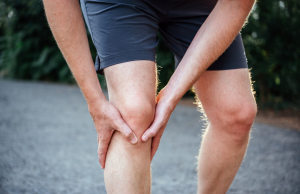
Knee bursitis happens when a bursa in your knee joint becomes inflamed. A bursa is a small slippery sac filled with fluid which helps to cut down on the friction that exists at your joints between your bones, muscles, and tendons. You have many bursae throughout your body, including 11 in your knee.
Many different things can cause your bursa to become inflamed, but it most commonly occurs on the sides of your knee or on the kneecap area. And it can also happen behind your knee. Bursitis in the knee may not only be painful, but it may hinder your ability to bend and straighten your knee full, and to move freely.
An Overview of Knee Bursae
Your knee is comprised of 11 bursae, each in a specific location. There are different types of knee bursitis, depending on which bursa or bursae are inflamed.
Prepatellar knee bursitis happens right on the kneecap area, and is sometimes referred to as popeye or carpenter’s knee. Infrapatellar bursitis occurs just below the kneecap, while suprapatellar bursitis is just above the kneecap. Bursitis on the outside of your knee may be located in your iliotibial band bursa.
If you have an inflamed bursa behind your knee, it is likely your semimembranosus bursa
Bursa sometimes become inflamed as part of an infection. Though less common, bursitis that is caused by an infection may also include fever and chills.
Who is Most Likely to Experience Knee Bursitis?
Many people experience knee bursitis because of an injury which may include a traumatic blow or merely wear and tear from overuse.
While anyone can suffer from knee bursitis, it is more common among middle aged and older people. Individuals with jobs that involve a lot of kneeling and bending for prolonged periods like plumbers may be more prone to knee bursitis. Certain types of athletes may also be at higher risk including runners or those who are more likely to fall or get hit hard on the knee playing sports like football or volleyball.
Signs & Symptoms of Knee Bursitis
Signs of knee bursitis may vary depending on which bursa are inflamed and the cause of the inflammation. Some common signs of knee bursitis include the following:
- You’ll likely experience discomfort/pain … Oftentimes the pain you experience from knee bursitis is subtle, starting more slowly and building up over time. People sometimes describe it as an achy or throbbing sensation, rather than a sharp or sudden type of pain.
- You may see some swelling in the affected area. Bursitis in the knee often is associated with some swelling in the. This can happen on any area of the knee including the front, sides and back.
- You likely will have difficulty bending or straightening your knee fully. When you have knee bursitis it tends to be harder to bend your knee. It can cause increased discomfort/pain and be difficult to do.
Best Treatment for Knee Bursitis
Depending on the severity of your knee bursitis, a qualified medical professional may recommend a variety of treatment approaches. Initially it is advisable to see if rest helps heal the inflammation, combined with regular icing and heat treatment, and possibly non-steroidal anti-inflammatory drugs (NSAIDs). Elevation and compression can also be beneficial. Sometimes wearing some sort of knee stabilizer or compression sleeve can help to provide some healing relief.
If your bursitis is more persistent and it is impacting your overall quality of life, you may consider asking your doctor about injectable medicines that help reduce the pain and inflammation. Depending on your injury, your doctor may also aspirate the injured area to remove any buildup of fluids.
In rare cases, surgery may be recommended for knee bursitis, where the affected bursa is taken out.
If you are suffering from ongoing knee pain, you should seek out qualified medical attention. Board certified orthopedic surgeon and sports medicine physician Dr. Stacie Grossfeld at Orthopaedic Specialists has served the needs of patients across Louisville, Kentucky and Southern Indiana for decades. For additional information or to schedule an appointment, call 502-212-2663. We accept most insurance plans and are welcoming new patients. Habla Espanola.










Recent Comments